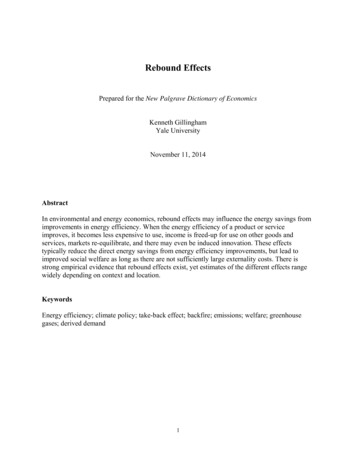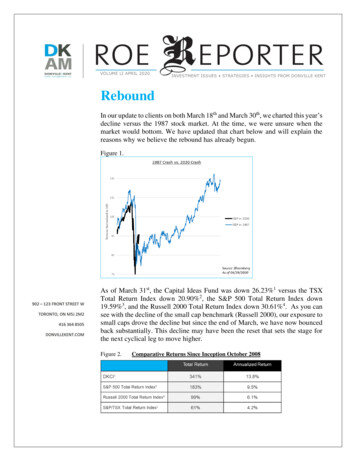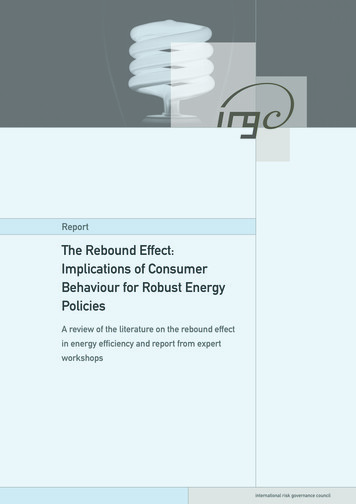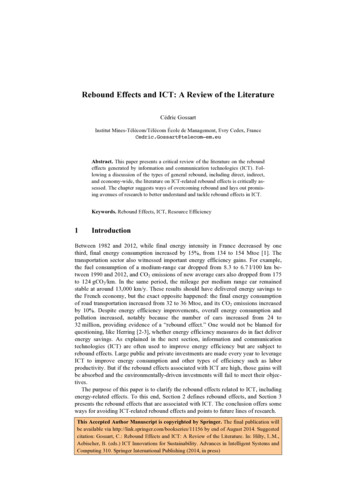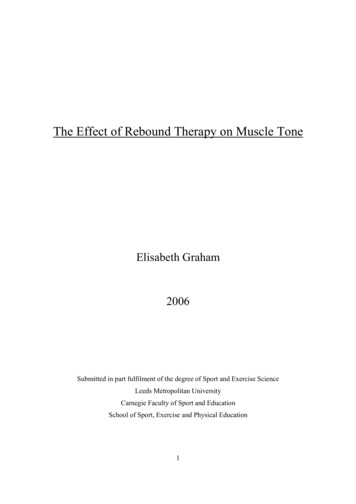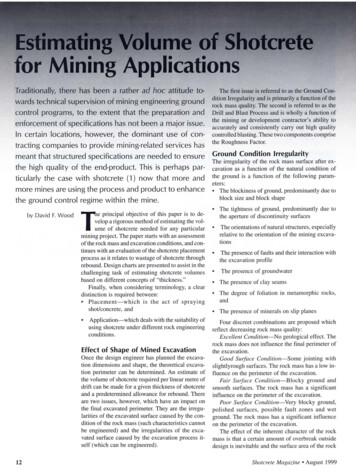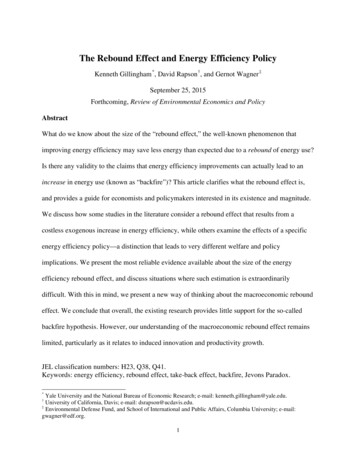
Transcription
The Rebound Effect and Energy Efficiency PolicyKenneth Gillingham *, David Rapson †, and Gernot Wagner ‡September 25, 2015Forthcoming, Review of Environmental Economics and PolicyAbstractWhat do we know about the size of the “rebound effect,” the well-known phenomenon thatimproving energy efficiency may save less energy than expected due to a rebound of energy use?Is there any validity to the claims that energy efficiency improvements can actually lead to anincrease in energy use (known as “backfire”)? This article clarifies what the rebound effect is,and provides a guide for economists and policymakers interested in its existence and magnitude.We discuss how some studies in the literature consider a rebound effect that results from acostless exogenous increase in energy efficiency, while others examine the effects of a specificenergy efficiency policy—a distinction that leads to very different welfare and policyimplications. We present the most reliable evidence available about the size of the energyefficiency rebound effect, and discuss situations where such estimation is extraordinarilydifficult. With this in mind, we present a new way of thinking about the macroeconomic reboundeffect. We conclude that overall, the existing research provides little support for the so-calledbackfire hypothesis. However, our understanding of the macroeconomic rebound effect remainslimited, particularly as it relates to induced innovation and productivity growth.JEL classification numbers: H23, Q38, Q41.Keywords: energy efficiency, rebound effect, take-back effect, backfire, Jevons Paradox.*Yale University and the National Bureau of Economic Research; e-mail: kenneth.gillingham@yale.edu.University of California, Davis; e-mail: dsrapson@ucdavis.edu.‡Environmental Defense Fund, and School of International and Public Affairs, Columbia University; e-mail:gwagner@edf.org.†1
INTRODUCTIONBuy a more fuel-efficient car, drive more. This is perhaps the simplest illustration of whathas come to be known as the “rebound effect”—the phenomenon that an increase in energyefficiency may lead to less energy savings than would be expected by simply multiplying thechange in energy efficiency by the energy use prior to the change. The existence of the reboundeffect has been clear for a long time. In fact, Jevons (1865) hypothesized that greater energyefficiency may even lead to a “backfire,” whereby industrial energy use increases. However, thesize of the rebound effect is much less clear. There is great variation in estimates, which stemsfrom differences in definitions of the rebound effect, as well as in the quality of the data and theempirical methodologies used to estimate it. This has clear policy implications because bothresearchers and policy makers need reliable information about the magnitude of the reboundeffect to evaluate the energy savings and economic welfare implications of energy efficiencypolicies. While the rebound effect is just one component of this more important analysis, it hasreceived significant attention, including in the popular media, which is often in search of‘counter-intuitive’ results.The goal of this article is to more clearly define the rebound effect in the context ofenergy efficiency improvements, including clarifying its various channels, and to critically assessthe literature that estimates its magnitude. In particular, we distinguish between the reboundeffect from a costless exogenous energy efficiency improvement—what we will refer to here as azero-cost breakthrough—and the rebound effect from an actual (typically costly) energyefficiency policy—what we will refer to here as a policy-induced improvement. Recognition of2
this distinction can be helpful for interpreting estimates in the literature, which often conflate thetwo, leading to inappropriate conclusions and an exaggerated rebound effect.The most common approach in the literature for estimating the rebound effect is toempirically estimate fuel price or operating cost elasticities of demand. However, such estimatesshould be treated with caution precisely because they conflate the zero-cost breakthrough andpolicy-induced improvement effects. When we consider the cumulative rebound effect,especially if we include rebound effects that may occur at the macroeconomic level, reliableempirical estimates are much harder to come by.The article is structured as follows. First we define the different components of therebound effect. Then we review the quantitative evidence in the literature on the differentmicroeconomic and macroeconomic channels of the rebound effect and discuss challenges toidentifying causal rebound effects for each channel. We conclude with a discussion of theimplications of the rebound effect for energy efficiency policy. 1DEFINING THE REBOUND EFFECTThe classic way that researchers have approached the rebound effect in the literature hasbeen to consider an improvement in energy efficiency and then compare the achieved reductionsin energy use to those forecasted without any consumer and market responses to the energyefficiency improvement. Such consumer and market-wide responses are likely to occur becausethe energy efficiency improvement itself changes relative prices (and, thus, real income). The1Throughout the article, we highlight common misconceptions about the rebound effect and how to address them.See the online supplementary materials for a table that summarizes the main misconceptions about the reboundeffect.3
rebound effect is then expressed as the percentage of the forecasted reduction in energy use thatis ‘lost’ due to the sum of the consumer and market responses.To illustrate, consider an air conditioner with annual electricity use of 100 kWh/year.Suppose a more efficient air conditioner shaved 10 kWh/year off this total before accounting forany consumer and market responses. If these responses increased electricity use by 1 kWh/year,then the rebound effect would be equal to 10 percent – i.e., 1 of the 10 kWh per year in expectedenergy savings would be “taken back” due to the consumer and market responses. 2Exogenous vs. “Bundled” Improvements in Energy EfficiencyAlthough this broad definition captures the essence of the rebound effect, it neglects theway in which energy efficiency is actually improved. The literature makes different assumptionsabout this key issue, which can cause misconceptions about exactly what the rebound effect is,how to estimate it, and how to interpret those estimates. It is helpful to begin with the distinctionbetween (1) an exogenous increase in energy efficiency (holding other product attributesconstant) and (2) a change in energy efficiency that is “bundled” with changes in other productattributes (e.g., a more energy-efficient air conditioner that is also smaller overall and, thus, canwork in different windows), which may induce a change in the energy service provided andperhaps also in the cost of the product. 3To illustrate this distinction, first consider an exogenous increase in energy efficiency—azero-cost breakthrough—in which an innovation allows a product (e.g., an appliance)2Here we follow the literature by defining the rebound effect with respect to energy. One could analogously definethe rebound effect with respect to emissions (Thomas et al. 2013), which in many cases is proportional to the energyrebound. Exceptions include biofuels policies that lead to indirect land use emissions, or policies that lead to fuelswitching, for example from coal to natural gas, and, thus, from carbon to methane emissions.3Energy is a demand that is derived from the consumers’ demand for energy services (e.g., miles driven in aparticular car, refrigeration). These energy services themselves may change along with the attributes of a product(e.g., a refrigerator with an ice maker provides a different energy service than a refrigerator without an ice maker).4
manufacturer to increase energy efficiency costlessly, while holding all other attributes of theproduct the same. The resulting consumer and market responses are a pure rebound effectbecause they capture only those responses induced by the improvement in energy efficiency.In contrast, consider a policy-induced improvement, whereby a policy requiresmanufacturers to improve the energy efficiency of a particular product. In this case, the energyefficiency improvement may be costly, potentially raising the price of the product. At the sametime, the policy may induce or even necessitate changes in other attributes of the product, such assize, weight or capacity. In this case, both the price of the product and the energy service itprovides may change along with the improvement in energy efficiency. 4Thus, for both estimation and policy purposes, it is crucial to distinguish between zerocost breakthroughs and policy-induced improvements. If we are seeking to estimate a responseattributed directly to an energy efficiency improvement, then the zero-cost breakthroughapproach is likely to be a better measure of the rebound effect. Any empirical estimation thatcontrols for all of the key attributes of a product is aiming to identify this pure effect. In fact, thisis the most common approach used to estimate what most researchers call the rebound effect.In contrast, if we are interested in the overall effect of a policy—the bundle of changesthat occurs, including but not limited to energy efficiency—then focusing on a policy-inducedimprovement is the appropriate approach. In this case, the goal would be to estimate a compoundeffect that combines the energy savings from the efficiency improvement with the energyadjustments due to changes in the attributes and cost of the product. This estimate may evencapture changes in sales of the product or other consequences. To calculate the policy-induced4There may be a continuum between zero-cost breakthroughs and policy-induced improvements, whereby arebound effect captures some, but not all, of the changes from a policy. However, such intermediate cases may bemore difficult to interpret in terms of policy implications. Thus, we focus our discussion here on the two extremes:zero-cost breakthrough and policy-induced improvement.5
improvement rebound effect, one could examine the difference in the forecasted energy savings(based on a simple engineering calculation) and the empirically estimated effect. This result maybe appropriate for considering the energy implications of a specific policy, but is generally notequivalent to the more ‘pure’ concept of the rebound effect represented by the zero-costbreakthrough approach.Which is the Preferred Approach for Policy Analysis?Neither the zero-cost breakthrough nor the policy-induced improvement approach isunambiguously a better choice for policy analysis. The choice depends on context, and thespecific question at hand. The zero-cost breakthrough approach, which isolates the effect of anexogenous energy efficiency improvement on the consumer and market responses, provides clearguidance on how changes in energy efficiency alone would change energy use. These results arelikely to be more widely applicable than focusing on a specific policy-induced improvement,because the approach holds constant potentially confounding variables. Thus, the results can beused to establish the degree to which the rebound effect improves social welfare by providingcheaper energy services that consumers value. Moreover, if policy-induced energy efficiencyimprovements are associated with only negligible costs and changes in attributes, then estimatesfor zero-cost breakthrough may be similar to those for policy-induced improvements. However,in most cases, an energy efficiency policy also causes changes in costs and attributes. It isdifficult to disentangle these responses empirically because it is essential to know all of thepertinent consumer and market responses to the improved efficiency, the changes in attributes,and the increased cost of the product itself. All of these responses (which comprise the policy’soverall effect) play a role in what ultimately matters most to policy makers: the energy efficiencypolicy’s effects on social welfare.6
MICROECONOMIC CHANNELS FOR THE REBOUND EFFECTBefore moving to empirical estimates of zero-cost breakthroughs and policy-inducedimprovements, it is useful to review some basic microeconomic theory to highlight the channelsby which the microeconomic rebound occurs. These channels stem from the classic substitutionand income effects of consumer theory. We focus only on consumer theory here, but addressrebound effects from producers in our discussion of the macroeconomic rebound.Substitution and Income EffectsWhen energy efficiency improves, the price of energy services changes. Substitution andincome effects arise, which influence consumers’ consumption of the energy services and,ultimately, energy use. Measuring these effects is not straightforward. In the case of a zero-costbreakthrough, the decline in the cost of the energy services implies that consumers will make aseries of four adjustments to their consumption bundle, 5 which may in turn affect their deriveddemand for energy. First, consumers will substitute towards the more energy-efficient product,which is now relatively less expensive. Second, consumers will substitute away from other nowrelatively more expensive goods. 6 Third, the lower effective price for the energy serviceincreases the consumer’s purchasing power, which means consumers will further increaseconsumption of the more energy-efficient product (assuming it is a normal good). Finally, theirincreased purchasing power means that consumers will also increase their consumption of othernormal goods. Each of these adjustments will either increase or decrease the amount of energyused for the consumer’s consumption bundle.5See Borenstein (2015) for a more technical discussion of these channels of behavioral adjustment. .More broadly, consumers will change their bundle of consumption towards complements to (and away fromsubstitutes for) the energy efficient product.67
The Direct Rebound EffectThese four effects do not perfectly match the terms most commonly used in the literatureon the rebound effect. The ‘direct rebound effect’ is generally defined as the change in energyuse resulting from the combined substitution and income effects on the demand for the energyefficient product (Sorrell et al. 2008). This definition is convenient because economists typicallyestimate elasticities of demand (e.g., the marginal change in demand for air conditioning as theoperating cost of the air conditioner changes), which can be easily converted into a directrebound effect. Using these elasticity estimates implicitly adopts the zero-cost breakthroughapproach to the rebound effect, since it tells us, e.g., how much additional air conditioningconsumers will use if their operating cost changes on the margin, holding all other productattributes constant. For example, if the elasticity of demand with respect to the operating cost is 0.5, then 50 percent of the reduction in energy use from an improvement in energy efficiency onthe margin will be “taken back” by the substitution and income effects, which increases theenergy use. 7 It is important to note that this estimate of the direct rebound effect ignores anychanges in the demand for other goods due to either the change in relative prices or purchasingpower. Nonetheless, the direct rebound effect is useful for quantifying and understanding thefirst order consumer response to an increase in energy efficiency.The Indirect Rebound EffectThe effect of an energy efficiency increase on the demand for all other goods, and thesubsequent change in energy use, is called the ‘indirect rebound effect.’ However, the literatureis not consistent in how this term is used. Some studies include any changes in energy useresulting from changes in the demand for other goods, including substitution effects, income7Note that this approach ignores the substitution and income effects on other goods.8
effects, and any embodied energy used to create the energy efficiency improvement (Azevedo2014). Other studies use the term “indirect rebound effect” even more broadly, by includingsubstitution effects, income effects, embodied energy, and even macroeconomic rebound effects(Sorrell et al. 2008). However, the most common approach in the literature is to refer to theindirect rebound effect as including only the income effects on the consumption of all othergoods. For example, buyers of a more fuel-efficient vehicle may decide to spend the savings on aflight for a vacation—another energy-intensive activity—or on something much less energyintensive, such as books and movies. The sign and magnitude of this indirect rebound effectdepends on the difference in energy intensity (per dollar) between the energy-efficient product(prior to the efficiency improvement) and other goods consumed on the margin. It is important torecognize that this more common definition of the indirect rebound effect ignores thesubstitution effects on other goods that arise from the decrease in the cost of using the moreenergy-efficient product. 8 Along the same lines, the literature commonly ignores any cost of theefficiency improvement, even though such a cost would produce income effects—reducing(increasing) the indirect rebound effect if, before the improvement, the energy-efficient productis more (less) energy intensive than the marginal consumption bundle (Borenstein 2015).The Microeconomic Rebound and WelfareThe income and substitution effects described here are no different from any otheradjustments that consumers make when confronted with a change in relative prices. By revealedpreference, consumers are enjoying private surplus gains. Thus, it follows that a net welfaredecrease from a rebound effect is only possible if the external costs associated with theseadjustments to the consumer’s consumption bundle outweigh the private gains. For example, the8These substitution effects are typically implicitly assumed away as being insignificant.9
external pollution costs from particularly dirty electricity use could outweigh the consumersurplus benefits from consumers increasing usage of a more efficient air conditioner and reoptimizing their consumption bundle. 9ESTIMATING MICROECONOMIC REBOUND EFFECTSWe now turn to estimation. Because the microeconomic rebound effect consists ofsubstitution and income effects across all goods, an attempt to fully measure the rebound effectwould require estimating the substitution and income effects for all goods in the economy—clearly an infeasible task. Instead, most studies ignore the demand for other goods and focus onestimating the price elasticity of demand for the more energy-efficient product—the zero-costbreakthrough approach. A few studies estimate the effect of a policy—the policy inducedimprovements approach—although again they generally ignore effects on other goods in theeconomy. There are also a few estimates of the income effects from changing the energyconsumption of all other goods, but these are generally based on the average rather than themarginal consumption bundle. We are not aware of any studies that estimate these own- andother-good effects jointly using comparable data sources. This may bias rebound effect estimatesbecause a greater increase in demand for the energy efficient product (i.e., direct rebound)generally implies a smaller increase in demand for other goods (i.e., substitution and incomeeffects on other goods) (Chan et al. 2014).CaveatsBefore discussing specific estimates, additional caveats are in order. First, to providereliable guidance for analyses, it is critical that studies estimate a causal effect. This is9See Chan and Gillingham (2014) for a detailed examination of these welfare effects.10
particularly important when using demand elasticities to quantify the rebound effect. 10 Forexample, studies that rely on cross-sectional variation in fuel prices or operating costs may havedifficulty controlling for unobserved heterogeneity. Such studies, even if otherwise wellexecuted, tend to find much more elastic demand than studies that include other sources ofvariation (e.g., see West (2004)).Second, the conversion of a demand elasticity into an estimate of the direct reboundeffect requires an assumption about symmetry of consumer response to changes in fuel pricesand energy efficiency. Under standard neoclassical assumptions, the utilization of an energyconsuming good is based on the operating cost (i.e., the fuel price divided by the energyefficiency). Therefore, a change in both the fuel price and in the energy efficiency of the goodwill change the operating cost in identical (but opposite) ways. Thus, it is common in theliterature to describe the fuel price elasticity of demand as being the direct rebound effect, as wewill see below. However, in settings where multiple energy services use the same fuel, the fuelprice elasticity and the direct rebound effect are not one and the same (Chan et al. 2014).Furthermore, recent evidence concerning passenger transportation suggests that consumers mayrespond less to changes in energy efficiency than to changes in fuel price (Gillingham 2011).This may occur because fuel prices are more salient: consumers see them every time they paytheir energy bill. In this case, using the fuel price elasticity of demand would overestimate thedirect rebound effect. However, other studies show either no asymmetry in response (Frondel etal. 2013) or a greater response to changes in energy efficiency than to changes in fuel price (Linn2013). One potential explanation for a greater response to changes in energy efficiency is theperceived longevity of such changes. Li et al. (2014) find that gasoline taxes appear to be more10Many studies estimating demand elasticities do not meet current standards for identification and fail to addressstandard endogeneity issues such as simultaneity.11
salient than fuel prices, perhaps again due to perceived longevity. Thus, further research isneeded into the symmetry of fuel price elasticities and energy efficiency elasticities.Third, the consumer response to any change in usage costs may vary depending on thetimeframe of the response. For example, when fuel prices change, in the short run consumers canchoose how many trips to take, what route to take, which vehicle to take (if they have multiplevehicles), and whether to take public transportation (if available). In the medium run, they canpurchase or scrap vehicles, and in the long run they can choose where to live and work. It islikely that long-run energy demand is more elastic than short-run demand; yet long-runelasticities are harder to estimate credibly, and thus harder to come by.Finally, each estimate of price elasticities is for a particular time and place, and energydemand could vary with the specific setting. For example, Gillingham (2014) shows that theelasticity of demand for driving with respect to the price of gasoline exhibits noticeableheterogeneity across different counties in California. One could imagine that there would be evengreater differences when examining a developing country or a country with an extensive publictransportation system. The bottom line here is that even if an elasticity estimate is internallyvalid, we need to examine its external validity before applying it elsewhere.With these caveats in mind, we next review the relevant elasticity estimates in theliterature that may be useful in providing policy guidance to economists and policymakers.12
Elasticities for Developed CountriesWe first discuss the literature for developed countries. Given the vast number ofestimates, we present selected reliable estimates, with a focus on studies of overall demand orhousehold-level demand (Table 1). 11Table 1. Selected elasticity estimates for developed countries.StudyType of price elasticityEstimatedValueAllcott (2011)Illinois short-run elasticity of electricity demand, 2003 &-0.12004Barla et al. (2009)Canada short-run elasticity of VMT demand, 1990-2004-0.08Frondel et al. (2013)Germany short-run elasticity of VMT demand, 1997--0.458ǂ2009Gillingham (2014)California medium-run new vehicle elasticity of VMT-0.23demand, 2001-2009Hughes et al. (2008)U.S. short-run elasticity of gasoline demand, 1975-1980-0.21 to -0.34Hughes et al. (2008)U.S. short-run elasticity of gasoline demand, 2001-2006-0.034 to-0.077Ito (2014)California medium-run elasticity of electricity demand,-0.0881999-2007Jessoe and Rapson (2014)Connecticut short-run elasticity of electricity demand,-0.12201111For more comprehensive reviews of estimates of elasticities in different sectors, see Greening et al. (2000); Sorrell(2007); Jenkins et al. (2011); and Gillingham (2011). Not surprisingly, these reviews show large ranges of estimatesin most sectors.13
Small and van Dender (2007)U.S. short-run elasticity of VMT demand, 1966-2001-0.045ᵞNotes: All electricity demand elasticity estimates are for residential customers. VMT refers to vehicle-milestraveled.ᵞ We use the estimate from the 1997-2001 period; earlier elasticities were higher in absolute value.ǂWe report the fixed effects estimate, which we believe to be the most reliable.The studies we include in Table 1 were selected because they are more recent and userigorous empirical methods such as panel data methods, experimental or quasi-experimentaldesigns. These studies attempt to address potential endogeneity concerns and present someevidence of internal validity. They tend not to rely exclusively on cross-sectional variation. Allprovide either short-run or medium-run estimates. As emphasized by Hamilton (2009) andGillingham (2011), including a lagged dependent variable to distinguish between short-run andlong-run responses requires strong assumptions. Yet, nearly all estimates of long-run responsesare based on either an ordinary least squares (OLS) regression with a lagged dependent variableor on cross-sectional variation (with the assumption that it is capturing a long-run equilibrium).Thus, we believe that the short-run and medium-run estimates are more reliable.The primary theme that emerges from our review of this literature is that the short-runand medium-run elasticities of demand for gasoline/driving and electricity are generally in therange of -0.05 to -0.40, suggesting a direct rebound effect on the order of 5 to 40 percent, withmost of the studies falling in the range of 5 to 25 percent. All of these studies focus on gasolineor electricity use, and it may not be appropriate to apply the estimates to other energy services,including those that use natural gas, heating oil, or other fuels. Unfortunately, there is scantevidence on the price elasticity of demand for other energy services; all of the published papers14
we could find are more than a decade old and use limited data. In a review of the older literature,Sorrell (2007) finds wide ranges for most residential energy services. Thus, we believe that newresearch is needed on these other energy services. Moreover, new studies are needed to help usidentify the size of the error from using own-price elasticities for the direct rebound.Most of the studies cited in Table 1 are for the U.S. Because each country has uniquecircumstances, it may be inappropriate to apply the estimates in Table 1 to other regions andcountries, both developed and developing. 12Elasticities for Developing CountriesFor developing countries, one might hypothesize a greater elasticity of demand to pricechanges, and thus direct rebound effect, because of the greater unmet demand for energyservices. However, there are a variety of country-specific factors that may affect responsivenessin any given market, such as the wealth of those who own vehicles or appliances. In our reviewof the literature, we found a surprising number of studies estimating elasticities of usage fordurable goods in low and middle income countries. However, the authors of these studies oftenface severe data limitations and measurement error in the data. Moreover, these studies rarelymeet current standards for identification in applied economics, and the caveats above certainlyapply here.Table 2 shows a representative sample of studies published in peer-reviewed journals.We have not screened these studies for reliability (as we did for the developed countries) becausenearly all of them face data limitations. We should, thus, be very cautious in viewing them as12For example, Frondel et al. (2013), which uses data for Germany—a country with better public transportation andhigher gasoline prices than the U.S.—finds a more elastic response in driving to changes in gasoline prices than theother studies in Table 1.15
causal estimates of price elasticities. These estimates of demand elasticities in developingcountries range widely, with the most common range on the order of -0.10 to -0.40 in the shortrun. Despite the limitations of some of these studies, it is interesting to note that the estimatedelasticities for developing countries are in the same range as the estimates for developedcountries.Table 2. Representative sample of recent price elasticity estimates for low and middle income countries.StudyType of elasticityEstimated ValueAl-Faris (2002)Gulf Cooperation Council short-run elasticity of total electricity-0.09demand, 1970-1997Alves et al. (2003)Brazil short-run elasticity of gasoline demand, 1974-1999-0.09Atakhanova et al. (2007)Kazakhstan short-run elasticity of electricity demand, 1994-2003-0.128ǂAthukorala et al. (2010)Sri Lanka short-run elasticity of total elasticity demand, 1960-2007-0.16Ben Sita et al. (2012)Lebanon short-run elasticity of gasoline demand, 2000-2010-0.623Crotte et al. (2010)Mexico short-run elasticity of gasoline demand, 1980-20060 to -0.15Halicioglu (2007)Turkey short-run elasticity
then the rebound effect would be equal to 10 percent - i.e., 1 of the 10 kWh per year in expected energy savings would be "taken back" due to the consumer and market responses. 2 Exogenous vs. "Bundled" Improvements in Energy Efficiency. Although this broad definition captures the essence of the rebound effect, it neglects the


